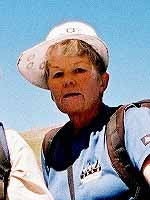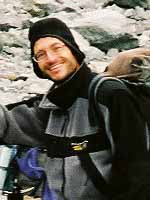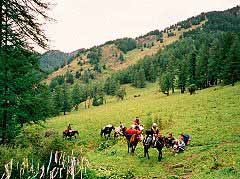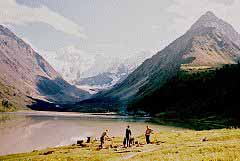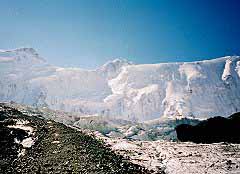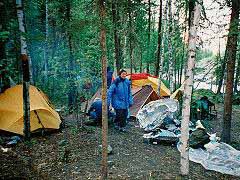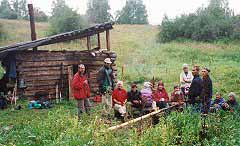

|
Jenny Paterson and Paul Stoddart Altai expedition, Siberia
The Altai region derives its name from a Mongol word - altan - meaning “golden” and the morning we started walking was truly that. Under bright blue skies with cottonwool clouds, a warm sun shone on happy faces as we sat after breakfast awaiting the arrival of the horses that would transport our baggage to base camp. We set off with our day packs, heading up the Kucherla Valley and our horses going up the gentler Akkem Valley, happy in the knowledge that we would meet up with them again before sunset. We walked through glorious meadows and forests on paths next to the Katun River and were quickly introduced to the strawberries, blackcurrants and every other kind of berry that had the Russians foraging like squirrels at every bush and thicket!
The gods were good to us the next day: it was spectacular. The sun shone brightly, the mountains surrounding the lake (which had been draped in mist when we arrived the previous day) were clear of mist and cloud and reached high up to the sky. In the distance was the awesome, beautiful, snow-topped, ice face of the Akkem Wall, nearly vertical and more than 1000m high, and what is called the Pic Delone-Belukha-Altai Crown cirque. Looking from left to right we stared at Delone (4070m), Belukha East (4506m) (one of our goals where we hoped to fly the South African flag for the first time), Belukha West (4460m) and Altai Crown (4167m) all shimmering like ice castles in the morning sun. On the right and closer to us was the dark mound of Bronya Peak (3250m), another of our goals. On the left was Karaoyuk (3950m) and in the centre running down to the lake the vast Akkem Glacier.
The next day we set off to climb Bronya Peak. We headed up the beautiful Valley of Seven Lakes, past a succession of waterfalls until we got to the inevitable glacial moraine and ultimately the glacier itself, which was easy enough to cross. Then the scrambling began! Up scree, rocks, more scree and more rocks. Our backpacks were left at a lunch spot about halfway up and we eventually summited at 3.20 p.m. We enjoyed the spectacular views from the top, especially of Mt Belukha and the gargantuan Akkem Glacier. The retreat of the glacier is clearly visible from above; Sasha estimated that it is receding at a rate of up to 100m a year. We left a summit note under a rock and took heaps of photos. A South African first!
At about 9.30 a.m. the next morning Anton rowed us across the lake in the rickety old boat, aptly named “Akkem”, as it let in water as fast as one baled it out! By walking around on the eastern shore we by-passed the mud of the west bank. This saved us from crossing the swiftly flowing river where it entered the lake. A torrent of glacial melt water, over a metre deep, is best avoided, even on a sunny Siberian summer's morning! We followed a well-marked path along the valley for about three kilometres until we reached the glacial moraine. This consists of an enormous heap of huge, jagged boulders, chiselled from the heights above by the forces of water and ice. From here it was steep going for two kilometres, with the rough path soon giving way to boulder-hopping. The route became a little easier once we reached Akkem Glacier, which we followed for a further three kilometres to Tomsk Bivouac (3200m), a very well constructed aluminium-clad wooden haven, as we were soon to find out. The storm clouds that had steadily been building up over the past few hours suddenly deepened and darkened and soon rain started pelting down. Thunder rolled all around us whilst the storm raged on furiously. Sleep was fitful that night... the wind howled and hit the hut like an unstoppable train. I had decided not to continue beyond this point and nor would Betty. On going outside the next morning, I knew (despite being deeply disappointed) that I had made the right decision as it had started snowing during the night and a fresh covering of snow was all around, the wind was still blowing gales and there was no doubt that the storm would continue that day - which it did, and only blew itself out during the night. We awoke next morning to a glorious day: bright, crisp blue skies and wispy white clouds scurrying about. After a quick breakfast, Betty and I set off to return to base camp. Paul
takes up the story: Next morning we checked the weather for an early start but decided to wait. Several inches of snow had fallen during the night. At 9 a.m. we started up towards TKT Pass in white-out conditions, but turned back after half an hour when visibility remained poor. I found the fresh snow quite disconcerting, as it very effectively hid several nearby crevasses that I'd noticed the day before. The weather next morning was partly cloudy but visibility was good, so we started at 6 a.m. and, with the Russians setting a typically cracking pace, we soon reached the alternative high camp below TKT Pass. Set in a dramatic cirque, this looked quite comfortable, with waist-high walls of compacted snow protecting the tent-sites. At this point we put on crampons and climbed a crevassed snow slope directly towards the ridge to the north of TKT Pass. This route, called Beluchinsky Pass, provides a more direct - although steeper -route to the summit. The final ascent to gain the ridge requires just over two pitches of ice climbing with poor protection from ice axe and ice screw belays (the slope was again about 45°). Once on the ridge, there was another 200 metres of height to be gained on mixed rock and ice to the summit. This was technically quite easy, but was made difficult by the cold, gusting wind. We reached the summit at 12.30 p.m. on Friday, 23 August 2002. Unfortunately the visibility was poor, with only an occasional glimpse of the neighbouring peaks through the cloud. The temperature on the summit was -5° C, but we estimated about -25° C with wind chill (for a 60 kilometre per hour wind). The gusts could have been up to 90 kph. We left a summit note in the aluminium canister, took photographs and returned to camp by 2 p.m. The view opened up on the descent, with a fantastic vista out over Mensu Glacier (the longest in the Altai range) and into the unexplored valleys to the south. We returned to base camp by the same route down the Akkem Glacier. Rather than take our chances on finding the boat, Sasha led us to a cable slung across the river. The icy torrent was now only waist high and, by walking fast, the pain only struck me when I was halfway across. The communal attitude of Russian mountaineers was evident from the abundant collection of damp, abandoned takkies lying around. By hurling these tatty wretches back over the river after each crossing, we all managed to keep our boots dry and our feet intact. I found the climb a fantastic introduction to snow and ice conditions and was particularly fortunate to be accompanied by three extremely strong and experienced mountaineers. There had clearly been a misunderstanding at some point, and Sasha seemed relieved afterwards to discover that I was inexperienced rather than plain clumsy. Whatever the case, I was thrilled to accept an ice screw as a memento of the first South African ascent. The range also offers scope for many more challenging routes, particularly on the huge Akkem Wall above Tomsk Bivouac. Jenny
continues with the story:
The horses did not arrive. It was a cold night, sleep was fitful, but everyone took it in the same spirit of adventure as they had been doing all along.
The next few days were spent in Moscow and St Petersburg doing the tourist thing. We bade another nostalgic farewell to Paul at the hotel, and Andrey and Marina who saw us off at the main train station. Another highlight of our trip, for me, was surely the sleeper train to and from St Petersburg. What a delight before the inevitable killing of time in airports, waiting for the planes that would ultimately bring us back to South Africa - filled with indelible memories of this wonderful experience! Service
provider: photos:
Jenny Paterson and Tunney Kirk
|
